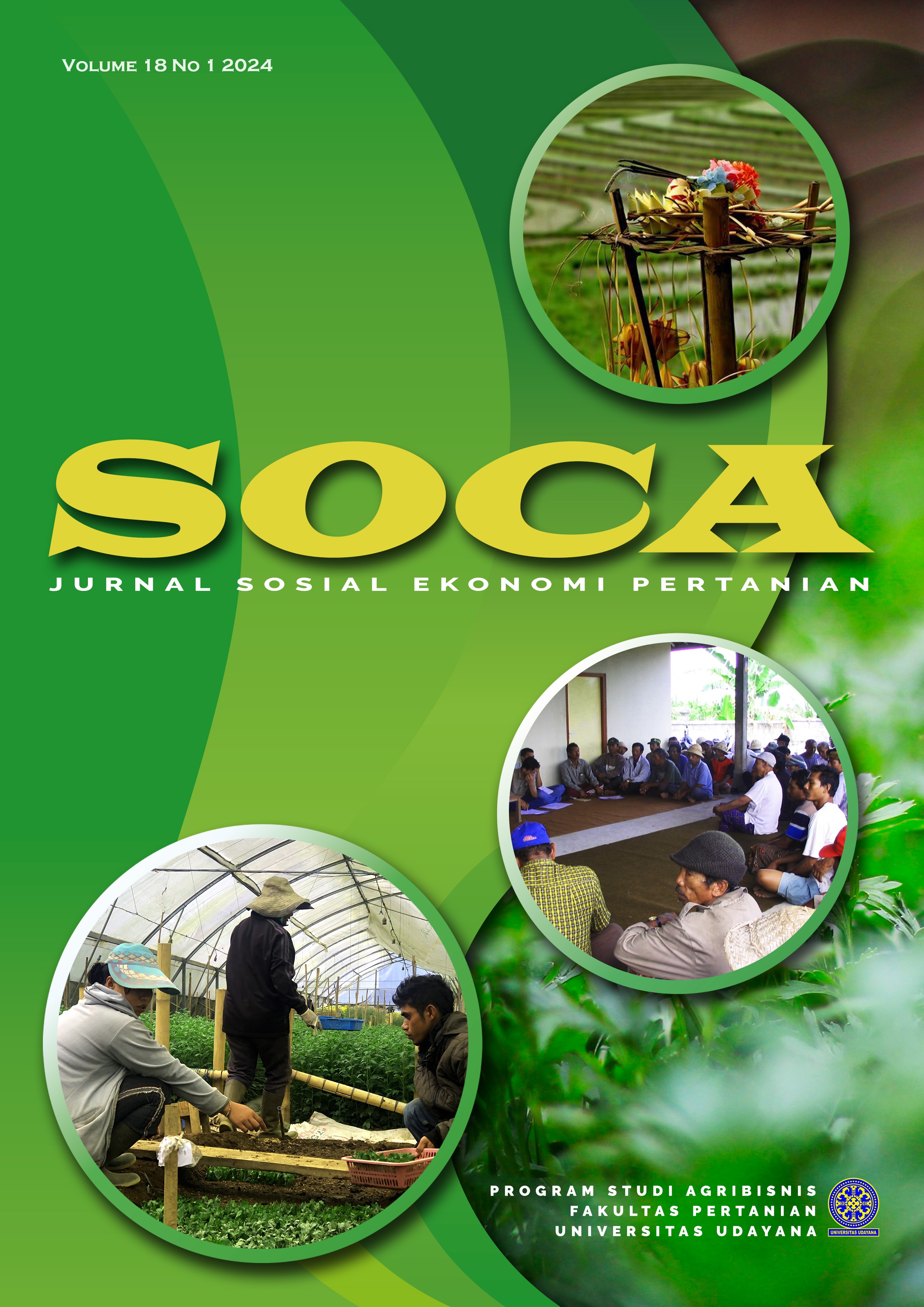Competitiveness of Indonesian Essential Oils in The International Market
Abstract
The limitation of technology poses a challenge in the essential oil industry in Indonesia. Indonesian essential oils are still exported in crude form, thus possessing low value-added. Meanwhile, Indonesia has 40 types of essential oils out of 80 traded globally, with 12 of them entering the global commercial market. Therefore, this research is intriguing to examine, aiming to 1) analyze the global market structure of essential oils, 2) analyze comparative competitiveness, and 3) the competitive advantage of Indonesian essential oils. The data consists of secondary data in the form of time series for the period 2012-2022. The data were analyzed using the Herfindahl Index, CR4, RCA, and EPD methods. The research findings indicate that the market structure of essential oils in the international market is oligopolistic with moderate concentration levels. Indonesia has a comparative advantage and strong competitiveness in all countries in this study. The condition of competitive advantage that occurred frequently during the period 2012-2022 in the five target countries is as follows: retreat, followed by rising star, then lost opportunity, and the least occurring is falling star
Downloads
References
Augustin, N. P., Prasetyo, E., & Santoso, S. (2022). Analisis Daya Saing dan Trend Ekspor Kakao Indonesia ke Lima Negara Tujuan Tahun 2010-2019. Jurnal Ekonomi Pertanian Dan Agribisnis, 6(2), 442-455. https://doi.org/10.21776/ub.jepa.2022.006.02.10
Badan Pusat Statistik. (2018). Statistik Perdagangan Luar Negeri Indonesia Ekspor, 2017, Jilid 1.
Badan Pusat Statistik. (2022). Buletin Statistik Perdagangan Luar Negeri.
Bikker, J. A., & Haaf, K. (2002). Competition, concentration and their relationship: An empirical analysis of the banking industry. Journal of banking & finance, 26(11), 2191-2214. https://doi.org/10.1016/S0378-4266(02)00205-4
Dewan Atsiri Indonesia (2017). Data Atsiri, Tanaman Atsiri, Negara Tujuan Ekspor. Tersedia pada: https://atsiri-indonesia.org/.
Estherhuizen, D. (2006). Measuring and Analyzing Competitiveness in the Agribusiness Sector: Methodological and Analytical Framework. University of Pretoria, 107(4), 823-824. doi: 10.1086/689555.
FAO. (2022). FAOSTAT. Food and Agricultural Organization. http://faostat.fao.org.
Hanafi, R. U., & Tinaprilla, N. 2017. Daya saing komoditas kakao Indonesia di perdagangan internasional. Jurnal Agribusiness Forum, 1 (7), 1-20. https://doi.org/10.29244/fagb.7.1.1-20
Hidayah, M., Fariyanti, A., & Anggraeni, L. (2022). Daya Saing Ekspor Cengkeh Indonesia. Jurnal Ekonomi Pertanian Dan Agribisnis, 6(3), 930-937. https://doi.org/10.21776/ub.jepa.2022.006.03.14
International Trade Center. (2023). Trade Statistics for International Business Development. Tersedia pada: https://www.trademap.org.
Kartika, P. F., Ferhat, A., & Bimantio, M. P. (2023). Competitiveness Analysis of Indonesia Essential Oils as an Export Commodity in the International Market Using Revealed Comparative Advantage (RCA) Method. Jurnal Sosial Ekonomi dan Kebijakan Pertanian (AGRISOCIONOMICS), 7(1), 144-154. https://doi.org/10.14710/agrisocionomics.v7i1.16369
Kementerian Pertanian Direktorat Jenderal Perkebunan. (2020). Harumnya Nilam Primadona Dunia. Tersedia pada: https://ditjenbun.pertanian.go.id/harumnya-nilam-primadona-dunia/.
Lindung, L., & Jamil, A. S. (2018). Posisi daya saing dan tingkat konsentrasi pasar ekspor karet alam indonesia di pasar global. Jurnal AGRISEP: Kajian Masalah Sosial Ekonomi Pertanian Dan Agribisnis, 119-128. https://doi.org/10.31186/jagrisep.17.2.119-128
McConnell, C. R., Brue, S. L., & Flynn, S. M. (2018). Microeconomics: principles, problems, and policies. McGraw-Hill.
Narulita, S., Winandi, R., & Jahroh, S. (2014). Analisis daya saing dan strategi pengembangan agribisnis kopi Indonesia. Jurnal Agribisnis Indonesia, 2(1), 63-74. https://doi.org/10.29244/jai.2014.2.1.63-74
Nurcahyani, M., & Salqaura, S. S. (2023). Analisis kinerja ekspor minyak atsiri Indonesia di pasar internasional. Jurnal Agribisnis Universitas Malikussaleh, 8(1), 51-57. https://doi.org/10.29103/ag.v8i1.11771
Nursodik, H., Imam Santoso, S., & Nurfadillah, S. (2022). Competitiveness of Indonesian Tea Export in Southeast Asia Markets. SOCA: Jurnal Sosial Ekonomi Pertanian, 16(1), 1-14. doi:10.24843/SOCA.2022.v16.i01.p01
Panorama, M. (2016). Struktur Pasar: Analisis Menggunakan Kurva. Yogyakarta: Idea Press Yogyakarta.
Pratama, A., Darwanto, D., & Masyhuri, M. (2020). Indonesian Clove Competitiveness and Competitor Countries in International Market. Economics Development Analysis Journal, 9(1), 39-54. https://doi.org/10.15294/edaj.v9i1.38075
Sembiring, B. S., & Syaukat, Y. (2021). Struktur Pasar dan Daya Saing Karet Alam Indonesia di Amerika Serikat. Buletin Ilmiah Litbang Perdagangan, 15(2), 235-256. https://doi.org/10.30908/bilp.v15i2.623
Simbolon, A. T. M., Jakfar, F., & Nugroho, A. (2022). Analisis Perdagangan Intra Industri Komoditi Teh Indonesia. Jurnal Ilmiah Mahasiswa Pertanian, 7(1), 141-149. https://doi.org/10.17969/jimfp.v7i1.18970
Sinta, N. M., Alamsyah, Z., & Elwamendri. (2017). Analisis Daya Saing Ekspor Kopi Indonesia dan Vietnam di Pasar ASEAN. Jurnal Ilmiah Sosio Ekonomika Bisnis, 20(1), 1–11. https://doi.org/10.22437/jiseb.v20i1.5028
Sleuwaegen, L., & Dehandschutter, W. (1986). The critical choice between the concentration ratio and the H-index in assessing industry performance. The Journal of Industrial Economics, 193-208. https://doi.org/10.2307/2098358
Tampubolon, J. (2020). Perdagangan dan Bisnis Internasional: Teori dan Analisis Empiris. Yogyakarta: Deepublish.
UN Comtrade. (2023). International Trade Statistic Database 2023. Tersedia pada: https://comtradeplus.un.org/.
Vonna, A. G., Indra, I., & Nugroho, A. (2020). Market Analysis of Patchouli Oil in Aceh Jaya Aceh Province. International Journal of Multicultural and Multireligious Understanding, 7(9), 388-400. http://dx.doi.org/10.18415/ijmmu.v7i9.2207
World Bank. 2022. World Bank Open Data. Tersedia pada: https://data.worldbank.org/.
Yu, C., & Qi, C. (2015). Research on the Complementarity and Comparative Advantages of Agricultural Product Trade between China and CEE Countries—Taking Poland, Romania, Czech Republic, Lithuania and Bulgaria as Examples. Journal of Service Science and Management, 8(2), 201-208. doi:10.4236/jssm.2015.82022













